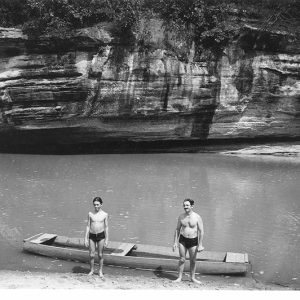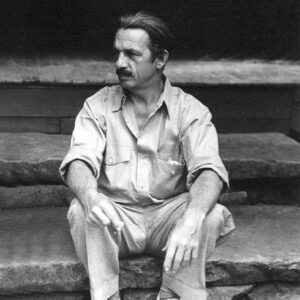calsfoundation@cals.org
Thomas Hart Benton (1889–1975)
Thomas Hart Benton—painter, muralist, and writer from Missouri—developed, along with artists Grant Wood and John Steuart Curry, a style of painting in the 1920s that became known as regionalism. Benton was influenced early in his career by a sketching trip he took through northwest Arkansas in 1926. He returned to Arkansas to sketch and paint periodically, primarily in the Buffalo River area. Benton also enjoyed floating and fishing on the Buffalo River and opposed efforts to dam it during the 1960s.
Tom Benton was born on April 15, 1889, in Neosho, Missouri. He was the oldest of four children born to Maecenus Eason (M. E.) and Elizabeth (Wise) Benton. M. E. was a lawyer and served as a congressman from 1897 until 1905. Benton was named for M. E.’s grand uncle, Missouri senator Thomas Hart Benton.
Benton began to have interest in art as a boy. He attended high school in Neosho in 1905–06, but he quit when he got a job drawing cartoons at The Joplin American newspaper. His father persuaded him to attend the Western Military Academy in Alton, Illinois, in 1906, but he dropped out in February 1907 and transferred to the Art Institute of Chicago. He left the institute and continued his artistic studies at the Académie Julien in Paris from 1908 to 1911. While his mother encouraged his artistic endeavors, his father did not.
Benton moved to New York City in 1912, where he struggled to make a living as an artist. During World War I, he served at a naval base in Norfolk, Virginia. To make money, Benton painted movie sets and taught at the Chelsea Neighborhood Association, in public schools, and at the Art Students League in New York. He married Rita Piacenza on February 19, 1922. An Italian immigrant and former student, she took an active role in Benton’s career, handling all of his business affairs so he could focus on art. The two remained married until his death.
In the early part of his career, Benton attempted to master several different styles of painting, including impressionism, pointillism, synchromism, and cubism. Though he achieved some success, he was largely unsatisfied with his efforts.
In 1924, Benton returned to Missouri to help care for his father, who was dying of cancer in a hospital in Springfield. The experience of reconciling with his estranged father and listening to old friends who came to visit at the hospital stirred up a longing to reconnect with his rural upbringing and to see the backwoods of America. Benton’s father died on April 27, 1924. Benton returned to New York, but he became increasingly disillusioned with the art scene there. He decided to travel around the country to capture the daily life of Americans at work and play.
His first sketching trip lasted for two months and began in the spring of 1926. Benton took a train from New York to New Orleans, then went north by towboat on the Mississippi River. He got off at Helena (Phillips County) and took a train to Little Rock (Pulaski County). He continued north from Little Rock, hiking fifteen to twenty miles per day, until he reached the Buffalo River area. Rambling about the backwoods of Newton County, Benton experienced a lifestyle largely unchanged since the 1890s. He sketched farmers working in their fields, church meetings, boys swimming, children in schoolhouses, and life around the town square. Benton stayed at the homes of farmers and backwoods hotels, including the Whiteley Hotel at Ponca (Newton County), and later wrote an article about his experiences for the July 1934 issue of Travel magazine.
This trip, the first of many similar journeys throughout the United States, was significant in the development of Benton’s artistic style. He sought to capture the American experience in a manner that made his art accessible to the mainstream public, an approach that put him at odds with other artists and critics. A number of lithographs and paintings resulted from this trip. His work was derided by some as cartoon-like, isolationist, jingoistic, and stereotypical. Others felt Benton’s work was original and full of energy. In 1934, Benton received acclaim when he was pictured in a self-portrait on the cover of Time magazine and in an associated article about the development of regionalism.
Some of his most famous works include Boomtown (1928), which captured a small town in Texas buoyed by an oil strike; Persephone (1939), a large nude; Prodigal Son (1943), a Depression-era scene of a man returning to his home, only to find it in ruins; and Hollywood (1937), which captured the film industry. His mural A Social History of the State of Missouri in the State Capitol was controversial for its inclusion of an infamous Kansas City mob boss and a lynching. He angered others by his inclusion of a coal miner’s strike and images of the Ku Klux Klan in another mural, A Social History of the State of Indiana. When critics called his murals “loud and disturbing,” Benton defended his methods by noting, “They represent the U.S. which is also loud and not in ‘good taste.’”
In 1935, Benton moved to Kansas City, where he joined the faculty of the Kansas City Art Institute (KCAI). He served on the faculty until 1941 and lived in Kansas City for the rest of his life. Benton’s most famous student was Jackson Pollock, who went on to emerge as a leader in the abstract expressionist movement and became known for his drip paintings.
In the late summer of 1939, Benton took his son Thomas Piacenza (T. P.) to Arkansas for two short vacations. The pair spent time floating and fishing the White and Buffalo rivers. Benton also sketched and painted the scenery there, resulting in the lithograph Down The River, which featured his son. Another product of these trips was a painting and lithograph of a White River scene, Shallow Creek.
Benton returned in the spring of 1940 with a group of his advanced students from KCAI. They spent about ten days sketching and painting in Newton County, near Jasper. The following year, Benton returned with yet another group of students.
It was about this time that Benton became acquainted with various Arkansas artists and writers. He met poet John Gould Fletcher, who introduced Benton to the artist Adrian Brewer in 1938. Benton knew artists Louis and Elsie Freund and was a periodic visitor at their home in Eureka Springs (Carroll County). He also knew Ozark writer Vance Randolph and illustrated some of his work.
Starting about 1965, Benton made annual trips to float the Buffalo River with a group of friends from Kansas City. Sometimes he fished or swam, but invariably he carried a sketch pad with him. He painted some of his best late works during this period, including The Chute-Buffalo River (1970) and Jon-Boat (1973). Benton also opposed damming the Buffalo River and wrote a letter to the Corps of Engineers to that effect. A short film, A Man and a River, which was produced under the auspices of the U.S. Environmental Protection Agency, was made about a Buffalo River trip that Benton made in 1973. The film was later shown at the park.
In 1974, Benton took on the job of painting a large mural on the history of country music for the Country Music Foundation in Nashville, Tennessee. The mural, which was titled The Sources of Country Music, intended to show the origins of a music that Benton loved. On January 19, 1975, Benton completed the mural. After dinner he went out to sign the painting. It was a bitterly cold night, and he had a heart attack and died in his studio in Kansas City. Benton’s ashes were buried beneath a tree on the property where he and his wife would summer on Martha’s Vineyard.
His paintings, drawings, and lithographs, many of which are of Arkansas scenes, are highly prized by museums and private collectors. Practically all major American museums have at least one Benton painting, including the Metropolitan Museum of Art, Whitney Museum, Dallas Museum of Art, and the Nelson-Atkins Museum of Art. His large paintings have been known to sell for more than $500,000, while prints often run from $1,000 to $10,000.
For additional information:
Adams, Henry. Thomas Hart Benton: An American Original. New York: Alfred A. Knopf, Inc., 1989.
Benton, Thomas Hart. “America’s Yesterday: In The Ozark Mountains of Arkansas—Life and Customs on a Forgotten Frontier.” Travel 63 (July 1934).
———. An Artist In America. 4th ed. Columbia: University of Missouri Press, 1983
W. Russ Aikman
University of Texas at Arlington
 Thomas Hart Benton and Daughter
Thomas Hart Benton and Daughter  Thomas Hart Benton and Son
Thomas Hart Benton and Son  Thomas Hart Benton
Thomas Hart Benton 




Comments
No comments on this entry yet.